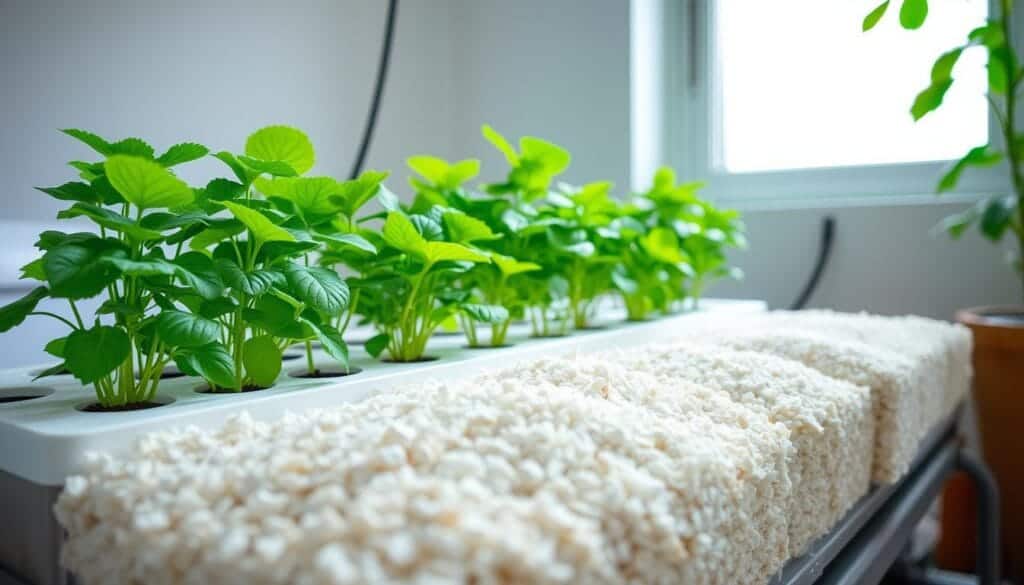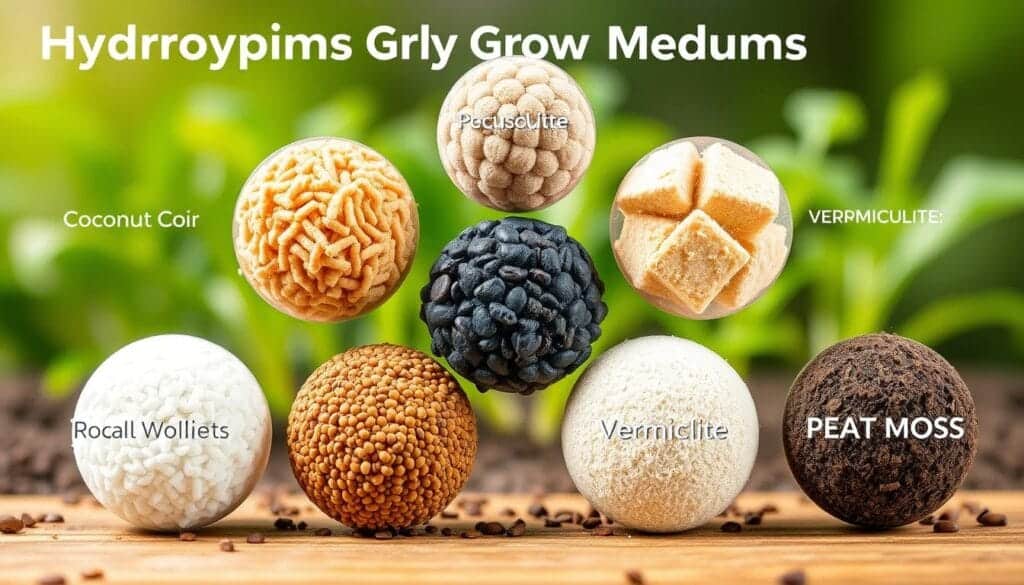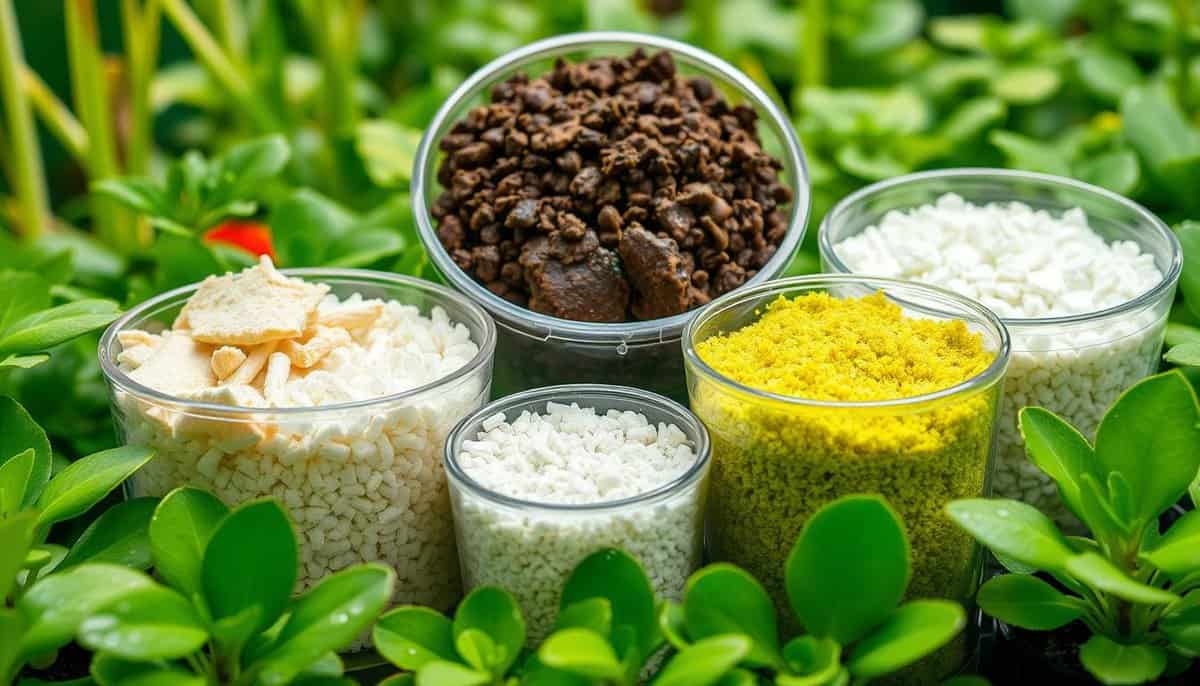Exploring hydroponic gardening, you’ll find many growing mediums that promise to help your plants grow. It’s hard to pick the best one for your needs. We’ll examine the top 6 hydroponic growing mediums, their benefits, and what makes them special. This will help you choose wisely, whether you’re new to gardening or experienced.
When comparing hydroponic growing media, consider how well they hold water, provide air, and stabilize pH. The right medium can make your plants grow better. We’ll discuss the best options, their good and bad points, to enhance your gardening journey.
Key Takeaways
- Hydroponic growing mediums play a key role in plant growth and development
- Choosing the right hydroponic grow media can greatly affect your plant’s health and productivity
- Knowing the characteristics and benefits of different hydroponic growing mediums is vital for making a good choice
- Comparing hydroponic growing media can help you find the best one for your needs
- The top 6 hydroponic growing mediums offer many benefits, like better water retention and aeration
- By picking the right hydroponic growing medium, you can create the best environment for your plants to thrive
Understanding Hydroponic Growing Mediums and Their Importance
Exploring hydroponics reveals the vital role of growing mediums. These mediums, or substrates, are key for plant growth. They offer nutrients, oxygen, and water to plants. Knowing about different substrates helps you choose the best for your system.
What Are Hydroponic Growing Mediums?
Hydroponic growing mediums replace soil in hydroponic systems. They come from materials like rock wool, coconut coir, and perlite. These mediums create the best-growing conditions for plants, boosting growth and productivity.
The Role of Growing Media in Hydroponics
Growing media in hydroponics serves several purposes. They support plant structure, enhance water and nutrient uptake, and keep roots healthy. The right media ensures your plants thrive.
Effective growing mediums hold water well, have good aeration, and maintain pH balance. These traits help you pick the best mix for your system.
Key Properties of Effective Growing Mediums
- High water retention capacity
- Good aeration and oxygen flow
- pH stability and buffer capacity
Understanding hydroponic mediums and their properties is key. It helps you build a thriving system that grows healthy plants.
Benefits of Using the Right-Growing Medium
Choosing the right growing medium is key for hydroponic gardening. The best medium for plants depends on your garden’s needs. A good comparison can help you decide.
Using the right medium boosts plant growth and yields. It also cuts down on water use. This makes your garden healthier and more efficient.
Key benefits include improved root development and better nutrient uptake. These lead to healthier plants and higher yields. When picking a medium, look at water retention, aeration, and pH stability.
Using the right medium also reduces waste and environmental impact. It ensures your garden runs efficiently and sustainably. Whether you’re new or experienced, comparing media can greatly improve your garden’s success.
Essential Characteristics of Quality Hydroponic Media
Choosing the right hydroponic growing medium is key for plant growth. Quality media should meet specific plant needs. It supports root growth and nutrient uptake.
Water Retention Capacity
A good medium holds water well but doesn’t get too wet. This is vital in hydroponics, where roots are always in a nutrient-rich solution. Proper water retention stops root rot and keeps plants moist.
Aeration and Oxygen Flow
Aeration and oxygen flow are critical in hydroponics. The medium should let oxygen reach the roots for healthy growth. Using organic hydroponic growing media helps with this.
pH Stability and Buffer Capacity
pH stability and buffer capacity are key. The medium should keep a stable pH, even with changing nutrient solutions. This prevents pH changes that stress plants.
Physical Structure and Durability
The medium’s physical structure and durability matter too. It should hold plant weight and keep its shape over time. This lets roots grow and the medium stay effective.
Rockwool: The Industry Standard Medium
Rockwool is a top pick for hydroponic growers. It’s known for holding water well and letting roots breathe. It works in many hydroponic setups, making it a go-to for growers.
Rockwool keeps water and air for roots. This is great for plants like tomatoes and cucumbers that need oxygen. Plus, it’s clean, which helps avoid diseases and pests.
Properties and Benefits of Rockwool
Rockwool comes from molten rock spun into fibers. It’s strong and lasts a long time. It also doesn’t squish down, even when wet, which is perfect for often-watered systems.
Best Practices for Rockwool Use
To use Rockwool well, soak it in water first. Make sure the nutrient solution’s pH is right for your plants. Keep an eye on the Rockwool’s temperature, as it affects plant health.

Environmental Considerations
Rockwool is loved by many growers, but its making can harm the environment. It’s made from natural stuff, but the process is energy-heavy. So, some growers are exploring greener options.
| Hydroponic Growing Medium | Benefits | Environmental Impact |
|---|---|---|
| Rockwool | Excellent water retention, aeration, and durability | High energy consumption during production, possible waste |
| Coco Coir | Sustainable, renewable, and biodegradable | Low environmental impact, can be composted |
Expanded Clay Pellets (LECA): The Reusable Solution
Expanded Clay Pellets (LECA) are a top choice for hydroponic growing media. They are reusable and offer many benefits. These include better aeration, water retention, and root growth.
LECA has several advantages:
- Reusability: You can sterilize and reuse LECA multiple times, saving money.
- Improved aeration: The clay pellets allow air to reach the roots, helping plants grow well.
- Water retention: LECA holds water well, so you don’t need to water as often.
LECA is a top hydroponic medium for plants. It’s versatile and effective. Whether you’re new or experienced, LECA is a great choice for your hydroponic setup.
Choosing the right hydroponic growing medium, like LECA, can improve your plant’s growth. LECA offers many benefits and is a reliable, reusable option.
| Hydroponic Medium | Reusability | Aeration | Water Retention |
|---|---|---|---|
| LUCA | Yes | Excellent | High |
| Rockwool | No | Good | Medium |
| Coco Coir | No | Fair | Low |
Coconut Coir: The Sustainable Alternative
When looking into hydroponic soilless mixtures, coconut coir stands out. It’s a green choice compared to traditional growing media. Coconut coir comes from coconut husks and is becoming more popular for its eco-friendly and cost-saving qualities.
Processing and Preparation
Coconut coir goes through several steps to get ready for use. It’s washed, dried, and buffered to remove salts and dirt. This makes it perfect for hydroponics, providing a clean space for plants to grow.
Advantages Of Traditional Media
Coconut coir beats traditional media in many ways. It holds water well, is airy, and keeps a stable pH. Plus, it’s a renewable resource, appealing to those who care about the planet. Using coconut coir in hydroponics offers several perks:
- Improved plant growth and yields
- Increased water efficiency
- Reduced waste and environmental impact
Adding coconut coir to your hydroponic setup makes your growing system more sustainable and efficient. With its many benefits, coconut coir is a great choice for your hydroponic endeavors.
Perlite and Vermiculite: Lightweight Champions
When choosing hydroponic substrate materials, you have many options. Perlite and Vermiculite are two favorites. They are light and hold water well. These are great for growers who want a light system but need good growing conditions.
Perlite is a volcanic glass that holds water and nutrients well. It’s also clean, which helps avoid diseases. Vermiculite is a mineral that keeps nutrients close to the roots. It’s natural and good at holding onto nutrients.
Using Perlite and Vermiculite has many benefits. They improve water and air for roots. They also help plants grow and reduce disease risks. Plus, they mix well with other substrates.
- Improved water retention and aeration
- Increased root growth and plant development
- Reduced risk of contamination and disease
- Easy to mix with other hydroponic substrate materials
Perlite and Vermiculite are top picks for hydroponic growing media. They help create a balanced growing medium. Mixing them with other substrates can tailor your growing medium to your plants’ needs.
Comparing the Cost and Effectiveness of Different Hydroponic Growing Mediums
Choosing the right hydroponic growth media is key. You must think about the cost upfront, the long-term expenses, and how it affects the environment.
Comparing hydroponic growing media is important. Look at how well they hold water, provide air, and keep pH levels stable.
Initial Investment Considerations
The cost to start a hydroponic system varies by medium. Rockwool might cost more at first, while coconut coir could be cheaper.
Long-term Cost Analysis
Think about the medium’s long-term value. Durability, reusability, and when you might need to replace it matter. For example, expanded clay pellets (LECA) can be used many times, saving money.
Environmental Impact Assessment
Consider the medium’s environmental impact too. Media like perlite and vermiculite are better for the planet because they’re made naturally and sustainably.

By comparing hydroponic growing media, you can pick the best one. Look for a balance between cost and being good for the environment.
| Hydroponic Growing Medium | Initial Cost | Long-term Cost | Environmental Impact |
|---|---|---|---|
| Rockwool | High | Medium | Medium |
| Coconut Coir | Low | Low | Low |
| Expanded Clay Pellets (LECA) | Medium | Low | Low |
Selecting the Perfect Medium for Your Setup
Choosing the right hydroponic medium is key to a successful hydroponic system. The medium you pick can greatly affect your plants’ health. Think about the plants you’re growing, the medium’s compatibility with your system, and your growing environment.
Consider the medium’s water retention, aeration, and pH stability. Plants have different needs. Some need lots of oxygen, while others like more water.
Here are some key things to think about when picking a hydroponic medium:
- Plant type: Choose a medium that fits your plants’ needs.
- System compatibility: Make sure the medium works well with your system.
- Climate and environment: Pick a medium that does well in your growing area’s conditions.
By considering these factors and picking the right medium, you can have a thriving hydroponic system. Research and compare different options to find the best one for you.
| Medium | Water Retention Capacity | Aeration | pH Stability |
|---|---|---|---|
| Rockwool | High | Good | Neutral |
| Coco Coir | Medium | Excellent | Neutral |
| Perlite | Low | Good | Neutral |
Conclusion: Maximizing Your Hydroponic Success Through Medium Selection
Starting your hydroponic growing journey means choosing the right growing mediums is key. You can pick from Rockwool, expanded clay pellets, coconut coir, perlite, or vermiculite. Each has its benefits that fit different needs.
Think about water retention, aeration, pH stability, and system compatibility when picking. Knowing about hydroponic substrate materials helps you make the best choices. This way, you can help your plants grow strong and healthy.

